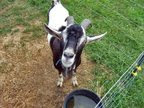Goats are one of the most versatile animals domesticated by man. Aside from meat and other products (fur, leather) goats also provide us milk and some milk products comparable to cattle. And all these, with only a modicum of goat care.
Dairy goats
Officially, the American Dairy Goat Association recognizes six breeds of goats that produce milk and milk products. They are Nubians, LaManchas, Alpines, Oberhaslis, Toggenburgs, and Saanens.
The Alpines (any color, medium-large, erect ears, straight face) is one of the two breeds (the other is the Saanens) that is popular with dairy farms because of the amount of milk they produce.
The Saanens (pure white) have large udder capacities and just as popular as Alpines because of the amount of milk they give out.
Nubians have long floppy ears and one of the larger breeds. Their milk is higher in protein and butter fat than the others. They are noisier and more stubborn.
The ears of LaManchas are so small it looks like they don’t have them. They are smaller, and they are calm and gentler than the others.
Oberhaslis are colored bay (chamoise) with a black dorsal strip. They have erect ears and are medium built.
The Toggenburgs are light brown with white erect ears and lower legs. They have shaggy coats and are popular among dairies, although smaller than most breeds.
Goat dairy products
Today, more people in the world are now drinking goat’s milk than cow milk. Nutritionally, they are similar but goat’s milk has smaller fat globules (does not need homogenization), thus easier to digest for some people.
Goat milk is now processed into various ice creams in health food stores. Goat cheese (chèvre, the French word for goat) is used in salads and in cooking because they are higher in protein but lower in fat than that made of cow’s milk.
Goat’s milk soaps are bruited to be creamier and richer than the others, and have added vitamins, minerals and proteins.
Advantages
In a comparison of milk contents of goats, cows and humans, goat’s milk tops the count especially in vitamins and some minerals. It levels with that of cow’s milk in proteins, but is the lowest in cholesterol count.
Goat milk is naturally homogenized. It has less lactose than cow’s milk and is less likely to trigger lactose intolerance in some people.
Goat’s milk is said to be more easily digestible than cow’s milk. This can be attributed to its casein curd which is softer and smaller than cow’s milk.
Milk boosters
As dairy goat raisers, you need to find ways and means to increase the milk production of your herd. The following are some of the ways.
Deworming your goats increases milk production. Illness and diseases (including anemia caused by worms and other parasites) slows down milk production, sometimes even stops it altogether.
Increase rations of high-quality hay. For high-milk production, alfalfa is one of the best because of high calcium content. Increased dry matter forage for the animals improves milk production.
It is also important that goat forage have high levels of fiber to promote increased rumen micro-flora which increases milk production.
Today, more and more goat raisers are into the business not just for the meat products. Goat care and raising them for dairy production also looks promising.







No comments:
Post a Comment